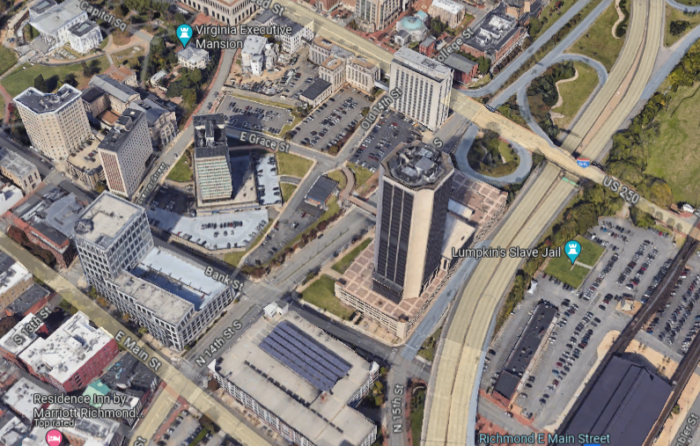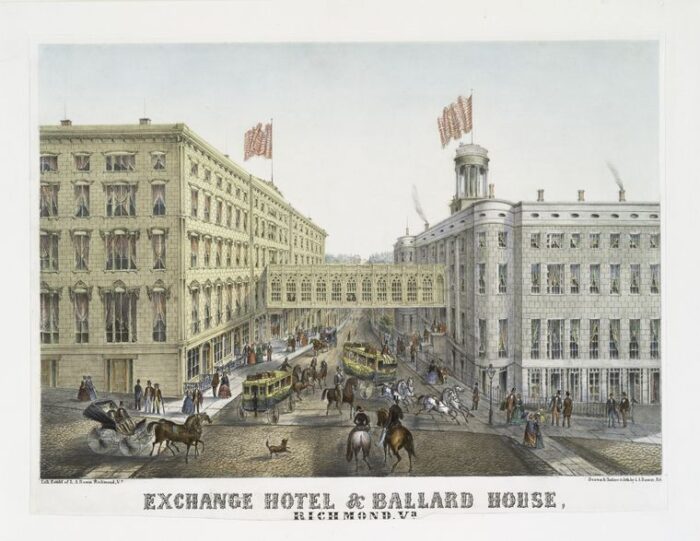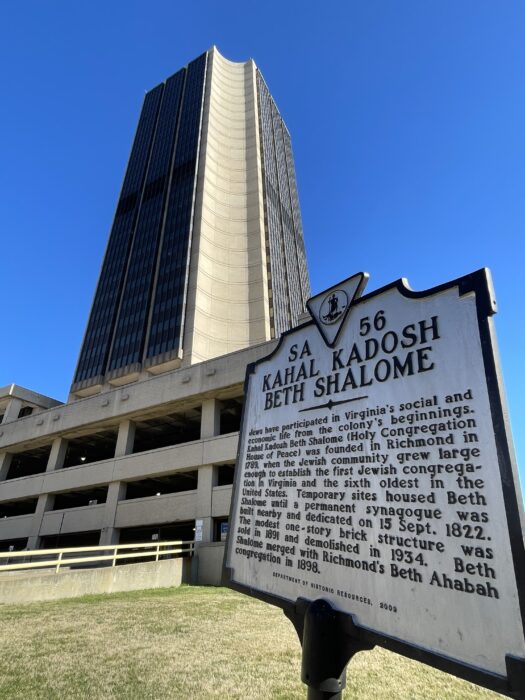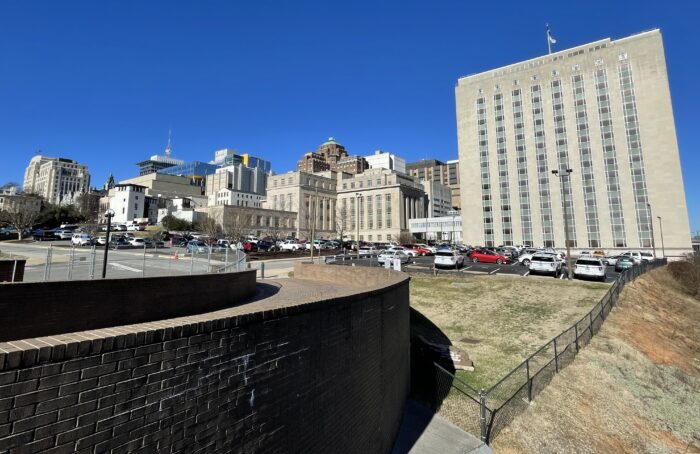
The “Eastern Quadrant” of Capitol Square is defined by Governor Street on the west, Interstate 95 on the east, East Broad Street on the north and East Main Street to the south.
Early last month, with the Virginia General Assembly descending on downtown for its 2024 session, Richmond Bizsense reported that the state has initiated a master plan process for the entire 46-acre Capitol Square compound. Especially intriguing is how 8 acres dubbed the “Eastern Quadrant” might be invigorated. This mostly desolate tract is defined by Governor Street on the west, Interstate 95 on the east, East Broad Street on the north and East Main Street to the south.
Truth to tell, with a dearth of architecturally worthy buildings (except for three handsome 175-year old Italianate row houses, Virginia Commonwealth University’s Memorial Hospital and the state transportation department buildings fronting Broad), the Eastern Quadrant is essentially an asphalt desert of parking lots. “Here,” according to the late, eminent architectural historian Mary Wingfield Scott: “… an atomic bomb could hardly have made a more complete clearance.”
And she wrote that in 1950. Despite the addition of the modernistic Madison and Monroe office towers, the hilly site has only become more woebegotten in the ensuing years. So, if help is on the way, it’ll be none too soon.
What happened to this forlorn urban landscape?
If the asphalt could speak, it’d remind us that this eastward sloping hillside was once a densely populated, mixed-use caldron of human activity. Two grand hotels, the Exchange and the Ballard House, flanked the intersection of East Franklin and 14th streets. Along narrow streets the homes of blacks and whites sat side by side or backed up to each other. The unchallenged finest house was Clifton, a neoclassical villa designed by English-born B. Henry Latrobe, our nation’s first professional architect. Nearby were entwined bars, gambling houses and brothel – red-light attractions within spitting distance of the Capitol. But in the spirit of “hate the sin not the sinner,” numerous churches and synagogues housed congregations here (which would gradually gravitate westward as frontier Richmond expanded).

The Exchange Hotel, which stood at the southeast corner of 14th and Franklin streets, was connected to the Ballard House.
This bureaucratically dubbed Eastern Quadrant once had a more distinguished moniker: Council Chamber Hill. It was named for a squat but stalwart brick building on the crest of the slope during the Revolutionary War. Here met Virginia’s influential Council of State, a precursor and adjunct to the General Assembly.
Currently, as the Commonwealth of Virginia and its Dallas-based consultant, AECOM (working with a $509,000 budget), develop a plan for Council Chamber Hill, they will surely examine its challenging topography and mostly forgotten, but colorful, history.
North-south-oriented Governor Street, now closed to public automotive traffic, still defines Council Chamber Hill. This evocative former cow path (which predates the downtown grid system) wiggles its way uphill from Shockoe Slip to East Broad. The handsome and former First Baptist Church (now smartly repurposed as a VCU student activities center) axially faces Governor Street. The building was designed by Thomas U. Walter, architect of the Capitol in Washington, D.C.
Respective houses of worship once dotted Council Chamber Hill. These served Lutherans, Methodists, Presbyterians, Universalists and Jews. The Beth Shalome synagogue would merge with Congregation Beth Ahabah (now located in the Fan District on West Franklin Street). When First Presbyterian Church moved from the decaying neighborhood, its sanctuary became a burlesque theater.
In the 18th and 19th centuries, wealthy Richmond residents often claimed prominent hilltops for their homes. In 1808, Latrobe designed a neoclassical villa on Council Chamber Hill at the corner of 14th and Apricot Alley for Benjamin James Harris. The mansion was later occupied by Sheltering Arms Hospital before the institution settled on East Clay Street in Court End.
The lure of the substantial Exchange and Ballard hotels (built in 1841 and 1855, respectively) attracted a number of upscale shops and celebrity visitors to the district. Charles Dickens stayed at the Exchange during his American lecture tour in 1842. While he found the lodgings commodious, Council Chamber Hill not so much: “… Jostling its handsome residences … are deplorable tenements, fences unrepaired [and] walls crumbling into ruinous heaps,” he wrote.
Queen Victoria’s son “Bertie,” the Prince of Wales, visited Richmond in 1860 and lodged at the Ballard. He was served by an enslaved man, John Cook, the hotel’s manager and a popular bartender. Although the future King Edward VII had attended services at St. Paul’s Episcopal Church and was feted at the Executive Mansion, apparently the only thing his royal highness would remember about Richmond was Cook’s mint juleps.
Former U.S. President John Tyler died at the Exchange Hotel while a guest there in January 1862.
After the Civil War, a less prominent resident who departed Council Chamber Hill was a young woman whose mother operated a “boarding” house in the neighborhood. In New York, Arabella Worsham was the mistress for 19 years – and eventually the wife – of Collis Hungtington, the Gilded Age railroad tycoon. The exotically decorated bedroom they shared in her midtown Manhattan home is now ensconced here on Arthur Ashe Boulevard in the American wing of the Virginia Museum of Fine Arts.
The Exchange and Ballard were demolished in 1900 and 1920, respectively. And the red-light district eventually evaporated. As historian Scott observed: “By 1928 the neighborhood was too down-at-heels to have any lure of sin.” In the mid-20th century, Council Chamber Hill had become a bustling center for printing, engraving and bookbinding. And along the Broad Street ridge the Virginia highway department had built two handsome office buildings.
Construction of Interstate 95 sheared off the eastern edge of Council Chamber Hill in 1956. Soon thereafter the state took a scorched-earth approach to clearing the area for surface parking lots and additional office buildings. The Monroe Building, a 29-story office behemoth, was built in 1981 on the eastern side of 14th Street. The Ballou Justice Upton-designed building was recently deemed expendable.
Most of the old neighborhood’s blocks have either disappeared or been reconfigured. Gone are thoroughfares such as Mayo and Ross streets or Locust and Trueheart Alleys. And historic Governor Street, which passes behind the Executive Mansion, is now closed as a public roadway; it is a de facto parking lot. But more positively, Morson’s Row, an 1853 Italianate landmark designed by architect Albert Lybrock, has recently been handsomely restored and awaits tenants (Glave & Holmes was the architect).
As the state and its consultants develop plans for the Eastern Quadrant, factors such as its proximity to Capitol Square and nearby transportation options like the interstate and the Amtrak railway station will be examined. And certainly, its dramatic geography, splendid views and storied history should provide rich fodder for architects and landscape architects. And importantly, the Alpine-like 8 acres form the hub of other emerging and dynamic historic neighborhoods – Shockoe Valley, Shockoe Slip, Court End and Capitol Square proper.
Editor’s note: A future commentary will offer specific ideas and suggestions for reinvigorating the Eastern Quadrant.

The “Eastern Quadrant” of Capitol Square is defined by Governor Street on the west, Interstate 95 on the east, East Broad Street on the north and East Main Street to the south.
Early last month, with the Virginia General Assembly descending on downtown for its 2024 session, Richmond Bizsense reported that the state has initiated a master plan process for the entire 46-acre Capitol Square compound. Especially intriguing is how 8 acres dubbed the “Eastern Quadrant” might be invigorated. This mostly desolate tract is defined by Governor Street on the west, Interstate 95 on the east, East Broad Street on the north and East Main Street to the south.
Truth to tell, with a dearth of architecturally worthy buildings (except for three handsome 175-year old Italianate row houses, Virginia Commonwealth University’s Memorial Hospital and the state transportation department buildings fronting Broad), the Eastern Quadrant is essentially an asphalt desert of parking lots. “Here,” according to the late, eminent architectural historian Mary Wingfield Scott: “… an atomic bomb could hardly have made a more complete clearance.”
And she wrote that in 1950. Despite the addition of the modernistic Madison and Monroe office towers, the hilly site has only become more woebegotten in the ensuing years. So, if help is on the way, it’ll be none too soon.
What happened to this forlorn urban landscape?
If the asphalt could speak, it’d remind us that this eastward sloping hillside was once a densely populated, mixed-use caldron of human activity. Two grand hotels, the Exchange and the Ballard House, flanked the intersection of East Franklin and 14th streets. Along narrow streets the homes of blacks and whites sat side by side or backed up to each other. The unchallenged finest house was Clifton, a neoclassical villa designed by English-born B. Henry Latrobe, our nation’s first professional architect. Nearby were entwined bars, gambling houses and brothel – red-light attractions within spitting distance of the Capitol. But in the spirit of “hate the sin not the sinner,” numerous churches and synagogues housed congregations here (which would gradually gravitate westward as frontier Richmond expanded).

The Exchange Hotel, which stood at the southeast corner of 14th and Franklin streets, was connected to the Ballard House.
This bureaucratically dubbed Eastern Quadrant once had a more distinguished moniker: Council Chamber Hill. It was named for a squat but stalwart brick building on the crest of the slope during the Revolutionary War. Here met Virginia’s influential Council of State, a precursor and adjunct to the General Assembly.
Currently, as the Commonwealth of Virginia and its Dallas-based consultant, AECOM (working with a $509,000 budget), develop a plan for Council Chamber Hill, they will surely examine its challenging topography and mostly forgotten, but colorful, history.
North-south-oriented Governor Street, now closed to public automotive traffic, still defines Council Chamber Hill. This evocative former cow path (which predates the downtown grid system) wiggles its way uphill from Shockoe Slip to East Broad. The handsome and former First Baptist Church (now smartly repurposed as a VCU student activities center) axially faces Governor Street. The building was designed by Thomas U. Walter, architect of the Capitol in Washington, D.C.
Respective houses of worship once dotted Council Chamber Hill. These served Lutherans, Methodists, Presbyterians, Universalists and Jews. The Beth Shalome synagogue would merge with Congregation Beth Ahabah (now located in the Fan District on West Franklin Street). When First Presbyterian Church moved from the decaying neighborhood, its sanctuary became a burlesque theater.
In the 18th and 19th centuries, wealthy Richmond residents often claimed prominent hilltops for their homes. In 1808, Latrobe designed a neoclassical villa on Council Chamber Hill at the corner of 14th and Apricot Alley for Benjamin James Harris. The mansion was later occupied by Sheltering Arms Hospital before the institution settled on East Clay Street in Court End.
The lure of the substantial Exchange and Ballard hotels (built in 1841 and 1855, respectively) attracted a number of upscale shops and celebrity visitors to the district. Charles Dickens stayed at the Exchange during his American lecture tour in 1842. While he found the lodgings commodious, Council Chamber Hill not so much: “… Jostling its handsome residences … are deplorable tenements, fences unrepaired [and] walls crumbling into ruinous heaps,” he wrote.
Queen Victoria’s son “Bertie,” the Prince of Wales, visited Richmond in 1860 and lodged at the Ballard. He was served by an enslaved man, John Cook, the hotel’s manager and a popular bartender. Although the future King Edward VII had attended services at St. Paul’s Episcopal Church and was feted at the Executive Mansion, apparently the only thing his royal highness would remember about Richmond was Cook’s mint juleps.
Former U.S. President John Tyler died at the Exchange Hotel while a guest there in January 1862.
After the Civil War, a less prominent resident who departed Council Chamber Hill was a young woman whose mother operated a “boarding” house in the neighborhood. In New York, Arabella Worsham was the mistress for 19 years – and eventually the wife – of Collis Hungtington, the Gilded Age railroad tycoon. The exotically decorated bedroom they shared in her midtown Manhattan home is now ensconced here on Arthur Ashe Boulevard in the American wing of the Virginia Museum of Fine Arts.
The Exchange and Ballard were demolished in 1900 and 1920, respectively. And the red-light district eventually evaporated. As historian Scott observed: “By 1928 the neighborhood was too down-at-heels to have any lure of sin.” In the mid-20th century, Council Chamber Hill had become a bustling center for printing, engraving and bookbinding. And along the Broad Street ridge the Virginia highway department had built two handsome office buildings.
Construction of Interstate 95 sheared off the eastern edge of Council Chamber Hill in 1956. Soon thereafter the state took a scorched-earth approach to clearing the area for surface parking lots and additional office buildings. The Monroe Building, a 29-story office behemoth, was built in 1981 on the eastern side of 14th Street. The Ballou Justice Upton-designed building was recently deemed expendable.
Most of the old neighborhood’s blocks have either disappeared or been reconfigured. Gone are thoroughfares such as Mayo and Ross streets or Locust and Trueheart Alleys. And historic Governor Street, which passes behind the Executive Mansion, is now closed as a public roadway; it is a de facto parking lot. But more positively, Morson’s Row, an 1853 Italianate landmark designed by architect Albert Lybrock, has recently been handsomely restored and awaits tenants (Glave & Holmes was the architect).
As the state and its consultants develop plans for the Eastern Quadrant, factors such as its proximity to Capitol Square and nearby transportation options like the interstate and the Amtrak railway station will be examined. And certainly, its dramatic geography, splendid views and storied history should provide rich fodder for architects and landscape architects. And importantly, the Alpine-like 8 acres form the hub of other emerging and dynamic historic neighborhoods – Shockoe Valley, Shockoe Slip, Court End and Capitol Square proper.
Editor’s note: A future commentary will offer specific ideas and suggestions for reinvigorating the Eastern Quadrant.


I’d like to have some street grid reinteoduced in this process. A mixed use neighborhood with homes, apartments, and businesses would be welcome if the state doesn’t need the entire space for itself. Among other streets, old 14th Street could be reopened for pedestrians or traffic.
Thank you for the dive into the history of this area, more pieces like this in RBS wouldn’t hurt.
Ed Slipek is the conscience of Richmond. Slipek for Mayor 2024!
He would have my vote!
If I wasn’t running, he would have to my vote as well. I would be honored to have Ed in my “Kitchen Cabinet.”
The diagram at the end of the article incorporates St. Paul’s Episcopal Church into Capital Square. This isn’t an appropriate separation of church and state.
One only needs to walk this area on a rainy January day to experience the soul sucking experience that is state government.
I really enjoyed reading about the history of Council Chamber Hill. I hope that the architecturally significant buildings mentioned will be preserved and the hideous others will be removed. The Soviet-era looking Monroe Building is an eyesore from all angles. It would be a miracle if our government leaders redevelop the acreage with something classic and worthy of Richmond’s place in American history. With pressure from constituents, they could be convinced to build something as beautiful as the new General Assembly Building.
Your comment had me thinking of this meme I collected recently.
Relevant or not here it is.
or a series of buildings that borrow from the West Hospital building – details, color and a sense of humanity.
Ed Slipek is a Richmond treasure. Every post on here from him I learn something new and interesting.